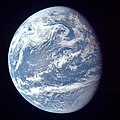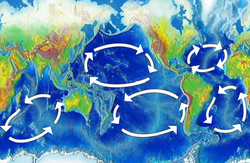A pycnocline is the cline or layer where the density gradient (∂ρ/∂z) is greatest within a body of water. An ocean current is generated by the forces...
11 KB (1,432 words) - 18:48, 16 February 2025
in temperature. A halocline can coincide with a thermocline and form a pycnocline. Haloclines are common in water-filled limestone caves near the ocean...
11 KB (1,067 words) - 03:45, 21 April 2025
temperature with depth change the density of the seawater, creating the pycnocline. The temperature of ocean water varies significantly across different...
37 KB (4,538 words) - 23:23, 4 May 2025
Law, Clifford S. (August 1993). "Evidence for slow mixing across the pycnocline from an open-ocean tracer-release experiment". Nature. 364 (6439): 701–703...
24 KB (2,669 words) - 08:38, 3 May 2025
Abyssopelagic Hadopelagic Demersal Benthic Stratification Pycnocline Isopycnal Chemocline Nutricline Halocline Thermocline ...
14 KB (1,440 words) - 01:14, 7 May 2025
lighter water, representing a stable stratification. For example, the pycnocline is the layer in the ocean where the change in density is largest compared...
37 KB (4,749 words) - 11:32, 15 March 2025
colder fresher surface layer and a colder more saline deeper layer. A pycnocline is a layer in a body of water where the change in density is relatively...
25 KB (3,133 words) - 01:34, 23 February 2025
winter surface mixed layer. The base of the CIL is marked by a major pycnocline at about 100–200 metres (330–660 ft), and this density disparity is the...
118 KB (12,042 words) - 11:08, 10 May 2025
can grow. Below the mixed layer, a region of rapid density change (or pycnocline) separates the upper and lower water, hindering vertical transport. Eddy...
21 KB (2,531 words) - 16:51, 16 August 2024
thermoclines (temperature), haloclines (salinity), chemoclines (chemistry), and pycnoclines (density). If a zone undergoes dramatic changes in temperature with depth...
129 KB (17,500 words) - 00:19, 5 May 2025
Abyssopelagic Hadopelagic Demersal Benthic Stratification Pycnocline Isopycnal Chemocline Nutricline Halocline Thermocline ...
19 KB (2,449 words) - 22:15, 9 February 2025
Abyssopelagic Hadopelagic Demersal Benthic Stratification Pycnocline Isopycnal Chemocline Nutricline Halocline Thermocline ...
25 KB (2,534 words) - 20:48, 28 January 2025
winds during the summer cause strongly stratified water column, with a pycnocline typically 10 meters below the surface (Cerco & Noel; Seliger et al.)....
122 KB (13,232 words) - 13:35, 25 April 2025
temperature, salinity and density called the thermocline, halocline, and pycnocline respectively. The temperature variations are large; from over 20 °C (68 °F)...
50 KB (6,021 words) - 06:42, 16 March 2025
Abyssopelagic Hadopelagic Demersal Benthic Stratification Pycnocline Isopycnal Chemocline Nutricline Halocline Thermocline ...
49 KB (5,362 words) - 13:11, 13 May 2024
Abyssopelagic Hadopelagic Demersal Benthic Stratification Pycnocline Isopycnal Chemocline Nutricline Halocline Thermocline ...
80 KB (9,036 words) - 16:02, 14 February 2025
Abyssopelagic Hadopelagic Demersal Benthic Stratification Pycnocline Isopycnal Chemocline Nutricline Halocline Thermocline ...
4 KB (543 words) - 07:07, 16 February 2025
Abyssopelagic Hadopelagic Demersal Benthic Stratification Pycnocline Isopycnal Chemocline Nutricline Halocline Thermocline ...
10 KB (1,123 words) - 11:32, 23 September 2024
increased in these areas because the nutrient-rich water lying below the pycnocline is relatively close to the surface and is thus easily upwelled. Scientists...
12 KB (1,513 words) - 05:58, 16 February 2025
Chemocline - chemistry Halocline - salinity Lysocline - dissolution of calcite Pycnocline - density Thermocline - temperature Pinti 2022. Emelyanov 2005, pp. 28...
2 KB (127 words) - 08:58, 30 April 2024
thermocline, chemocline (chemical gradient), halocline (salinity gradient) or pycnocline (variations in density of water induced by temperature or salinity). ecocline...
16 KB (1,832 words) - 12:59, 22 January 2025
Gyre is a cold, low salinity surface layer separated by a thin, weak pycnocline from a thick layer of relatively warm and salty water referred to as Weddell...
18 KB (2,092 words) - 10:52, 17 March 2025
the surface and more saline water as the depth increases. Many have pycnoclines and haloclines that show these zones, similar to the ocean around it...
20 KB (2,423 words) - 02:06, 28 February 2025
Abyssopelagic Hadopelagic Demersal Benthic Stratification Pycnocline Isopycnal Chemocline Nutricline Halocline Thermocline ...
25 KB (2,957 words) - 05:39, 27 February 2025
where fresh and brackish waters meet. The salinity fronts are also pycnoclines due to the water density discontinuities. They play an important role...
31 KB (3,189 words) - 19:11, 28 February 2025
the surface layer involves the top 100–150 m (330–490 ft), down to the pycnocline of increased density. In calm water, the first sea ice to form on the...
45 KB (5,558 words) - 05:52, 2 May 2025
a unique, spiraled shape, increasing the surface area covered in the pycnocline and increasing the potential of trapping prey. Vertical displacement for...
6 KB (768 words) - 21:38, 28 April 2024
mix with the deeper cooler layer of water that is situated below the pycnocline. This mixing introduces nutrients from deeper cooler water to the warmer...
69 KB (8,291 words) - 15:27, 3 February 2025
waves, initiated by seabed topography, that propagate on the oceanic pycnocline. Atmospheric solitons also exist, such as the morning glory cloud of the...
41 KB (4,513 words) - 18:31, 19 February 2025
to the North Sea. A strong pycnocline separates fresh surface water from dense, saline bottom water, and this pycnocline reduces mixing between the layers...
54 KB (6,637 words) - 11:13, 9 April 2025


















